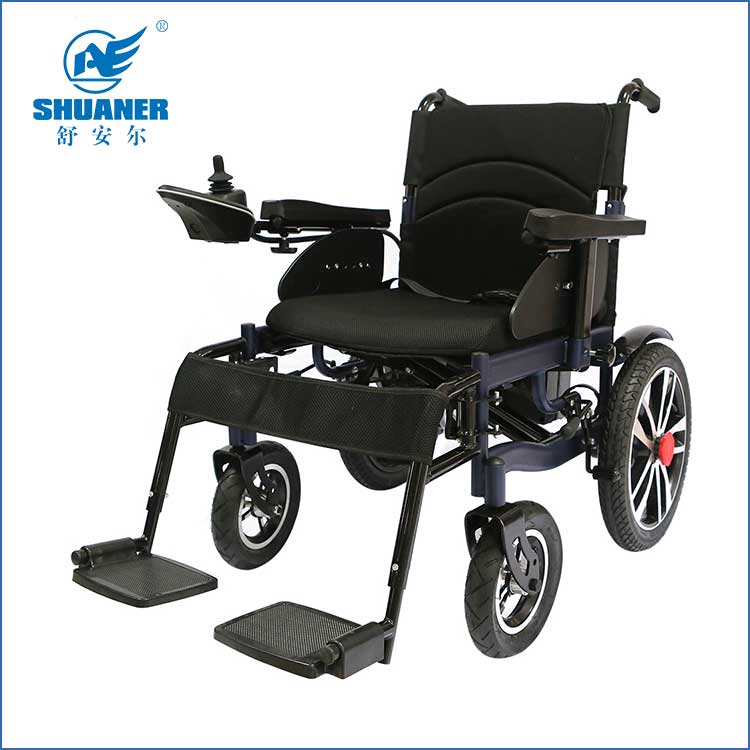- English
- Español
- Português
- русский
- Français
- 日本語
- Deutsch
- tiếng Việt
- Italiano
- Nederlands
- ภาษาไทย
- Polski
- 한국어
- Svenska
- magyar
- Malay
- বাংলা ভাষার
- Dansk
- Suomi
- हिन्दी
- Pilipino
- Türkçe
- Gaeilge
- العربية
- Indonesia
- Norsk
- تمل
- český
- ελληνικά
- український
- Javanese
- فارسی
- தமிழ்
- తెలుగు
- नेपाली
- Burmese
- български
- ລາວ
- Latine
- Қазақша
- Euskal
- Azərbaycan
- Slovenský jazyk
- Македонски
- Lietuvos
- Eesti Keel
- Română
- Slovenski
- मराठी
- Srpski језик
What factors should be considered when buying an electric wheelchair
2025-01-07
There are several factors to consider when buying an electric wheelchair to ensure you get the right product for your needs. Here are some key factors to consider when buying an electric wheelchair:
1. The user's physical condition and needs
Weight and size: Make sure the electric wheelchair's weight capacity can accommodate the user's weight and size. Choose the right seat width and depth to avoid discomfort or inability to use the wrong wheelchair.
Disability type: Choose the right electric wheelchair based on the user's disability type. Different wheelchairs are designed to accommodate different functional needs.
2. Type of wheelchair
Standard electric wheelchair: Suitable for daily use, suitable for driving indoors or on flat roads.
All-terrain electric wheelchair: Suitable for use on different types of surfaces, generally with larger wheels and a stronger power system.
Detachable or foldable electric wheelchair: Suitable for users who need to go out or travel frequently, easy to store and transport.
Sports electric wheelchair: Suitable for users who need higher speed and maneuverability, usually designed to be more flexible and sporty.
3. Battery performance
Battery life: Consider the battery life when choosing an electric wheelchair. Generally speaking, the range of an electric wheelchair is between 15 and 30 kilometers, depending on factors such as battery capacity, wheelchair weight, user weight, and usage environment.
Charging time: Understand the time it takes to charge the battery. Some electric wheelchair batteries take 4-6 hours to fully charge. Choose a wheelchair with a moderate battery charging time.
Battery type: Electric wheelchairs usually use lead-acid batteries or lithium batteries. Lithium batteries are lighter, have longer battery life, and charge faster than lead-acid batteries, but they are usually more expensive.
4. Wheelchair power and speed
Maximum speed: The maximum speed of an electric wheelchair is generally between 6 and 10 kilometers per hour. The choice should be based on the user's usage needs. Higher speeds are suitable for users who need more mobility, but safety also needs to be considered.
Electric motor power: The motor power of different wheelchairs is different. Generally, the power of electric wheelchairs is between 200W and 500W. When the motor power is larger, it can provide better support on more complex terrain (such as ramps and rugged roads).
5. Comfort and seat design
Seat width and depth: Choose the appropriate seat width and depth according to the user's body shape to avoid discomfort during long-term use.
Seat material: Choose a seat material with good breathability to improve comfort. Some wheelchairs also have adjustable backrests, seat cushions and armrests for increased comfort.
Seat and backrest adjustment function: Some electric wheelchairs provide seat and backrest angle adjustment functions, which helps to improve the user's comfort, especially when used for a long time.
6. Ground adaptability and wheel type
Front and rear wheel design: The front and rear wheel design of an electric wheelchair affects its driving stability. Larger rear wheels are suitable for outdoor use, while smaller front wheels are suitable for indoor use. For wheelchairs that need to be used in different environments, it is better to choose a design that is multifunctional and can adapt to different ground surfaces.
Tire material: Rubber or pneumatic tires are suitable for outdoor use and provide better shock absorption. Solid tires do not need to worry about leaks and are suitable for long-term use.
7. Control method
Manual control vs. automatic control: The control method of an electric wheelchair is usually achieved through a joystick, joystick or other electronic device. Make sure to choose a control method that suits the user's hand function and operating habits.
Intelligent control function: Some electric wheelchairs are equipped with intelligent control systems, which can be controlled through Bluetooth, APP and other functions, so that users can make some personalized settings.
8. Safety and stability
Braking system: Make sure the wheelchair has a reliable braking system and can park safely on ramps or complex terrain. Electric wheelchairs are usually equipped with electronic brakes or manual brake systems.
Stability design: Pay attention to whether the wheelchair is designed with good stability, especially when turning and climbing, to avoid the risk of tipping over.
Night safety: Some electric wheelchairs are equipped with reflective materials or LED lights to increase safety when used at night.
9. Weight and portability
The weight of an electric wheelchair directly affects its portability. If you need to use it frequently, it will be more convenient to choose an electric wheelchair that is lightweight and easy to fold or disassemble.
Removable battery: If the battery is heavy, choosing an electric wheelchair with a removable battery will help reduce the burden when carrying.
10. Price and after-sales service
Budget range: The price of electric wheelchairs varies depending on the brand, function and design. Choose a suitable model according to your own budget.
Warranty and after-sales: Understand the after-sales service policy when purchasing so that you can get timely help when you encounter problems during use.
11. Brand and reputation
Choosing an electric wheelchair with a good brand reputation and reputation can ensure product quality and after-sales service. You can refer to other users' reviews or consult professional medical equipment suppliers.
In summary, when purchasing an electric wheelchair, you should consider the type, comfort, power, endurance, safety, controllability and other factors of the wheelchair according to the actual needs of the user. Make sure that the selected electric wheelchair can meet the user's daily activity needs and provide sufficient comfort and convenience.




